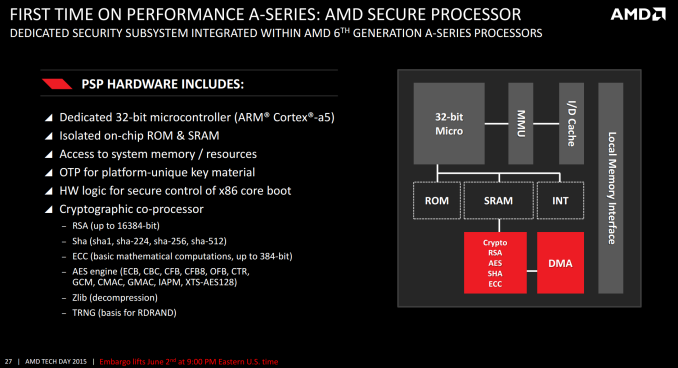AMD Launches Carrizo: The Laptop Leap of Efficiency and Architecture Updates
by Ian Cutress on June 2, 2015 9:00 PM ESTAMD Secure Processor
One of the final pieces in the puzzle is AMD’s Secure Processor, which they seemed to have called the PSP. The concept of the security processor has evolved over time, but the premise of a locked down area to perform sensitive work that is both hidden and cryptographically sealed appeals to a particular element of the population, particularly when it comes to business.
AMD’s PSP is based around a single 32-bit ARM Cortex-A5, with its own isolated ROM and SRAM but has access to system memory and resources. It contains logic to deal with the x86 POST process but also features a cryptographic co-processor.
ARM has been promoting TrustZone for a couple of years now, and AMD has been tinkering with their Secure Processor proposition for almost as long although relatively few explanations from AMD outside ‘it is there’ have come forward.
Final Thoughts
Sometimes a name can inspire change. Carrizo isn’t one of those names, and when hearing the words ‘AMD’s notebook processor’, those words have not instilled much hope in the past, much to AMD’s chagrin no doubt. Despite this, we come away from Carrizo with a significantly positive impression because this feels more than just another Bulldozer-based update.
If you can say in a sentence ‘more performance, less power and less die area’, it almost sounds like a holy trifecta of goals a processor designer can only hope to accomplish. Normally a processor engineer is all about performance, so it takes an adjustment in thinking to focus more so on power, but AMD is promising this with Carrizo. Part of this will be down to the effectiveness of the high density libraries (which according to the slides should also mean less power or more performance for less die area) but also the implementation of the higher bandwidth encoder, new video playback pathway and optimization of power through the frequency planes. Doubling the L1 data cache for no loss in latency will have definite impacts to IPC, as well as the better prefetch and branch prediction.
Technically, on paper, all the blocks in play look exciting and every little margin can help AMD build a better APU. It merely requires validation of the results we have been presented along with a killer device to go along with it, something which AMD has lacked in the past and reviewers have had trouble getting their hands on. We are in discussions with AMD to get the sufficient tools to test independently a number of the claims, and to see if AMD’s Carrizo has potential.











137 Comments
View All Comments
D. Lister - Wednesday, June 3, 2015 - link
Calling an unlaunched product "bad" would be just as imprudent as calling it "good", but then what do I know, fortune-telling could be just another one of your super powers, along with mind-reading.Gigaplex - Thursday, June 4, 2015 - link
Why would they use an Intel chip to fake a bar graph? Just put fake numbers directly into a spread sheet, job done.Dirty_Punk - Wednesday, June 3, 2015 - link
Unfortunatelly, time to market, as always for AMD, will be probably 6 month or more... at that time there will be something better from intel. It seems a lot like Asus from this point of view, grat product and very bad supply chain.AMD has 3 problems ritght now:
1- with 28nm is difficult to compete against 14nm of intel
2- very slow from project design to mass production
3- no support from OEM and major system builders (HP & co.), as it seems always that Intel works to force system builder to forget about AMD like years ago...
jabber - Wednesday, June 3, 2015 - link
Yep this time next year when you walk into a PC store you'll still see 25 Intel laptops and one cheap nasty AMD laptop on the shelves. OEMs don't care about AMD anymore. From what I see from customers is, that they only buy AMD if they are the cheapest machine in the shop. And then its a E1 chip and the customer really regrets it.haukionkannel - Wednesday, June 3, 2015 - link
That problem 1 is the worst! AMD APUs are ok, but 28nm vs Intel 14nm is just a huge deal. When considering power and efficiency and how much they can put on the chip.jimjamjamie - Wednesday, June 3, 2015 - link
HP is actually pretty good for offering a good selection of AMD-powered laptops, usually the cheaper models. Better than most other OEMs though.bloodypulp - Wednesday, June 3, 2015 - link
The only decent laptops HP makes are the Elitebooks. And you will pay through the nose for them when you can get better quality from other brands for less. HP should just stop making PCs, period.UtilityMax - Wednesday, June 3, 2015 - link
HP has several models with AMD chips. It's one of them few laptop makers that allows you to configure an Envy laptop with say a 1080p screen, SSD, a A10 CPU, plus discrete graphics.jabber - Thursday, June 4, 2015 - link
And I bet they sell about 8 of those AMD based machines a year.watzupken - Thursday, June 11, 2015 - link
Point 2 is probably their killer to be honest. Point 1 is definitely puts AMD in a disadvantage, but considering that Intel don't seem to be interested in pushing performance since its Sandy Bridge days, it's giving AMD a chance to catch up in terms of performance.To be honest, I think I have to take my hat off AMD's efforts. At 28nm, they are forced to be as creative as they can to squeeze performance out, while keeping power requirements in check.